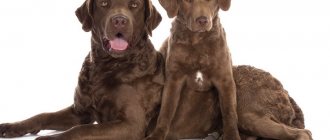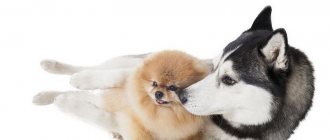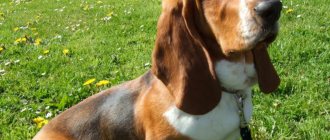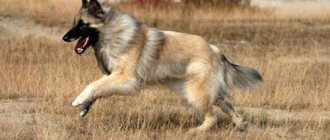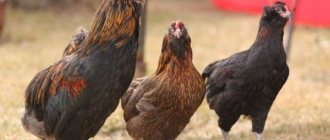The Australian Labradoodle is a unique “designer” breed of dog. It was specially developed in the middle of the last century, and we can definitely say that work on it is not finished yet.
Another name for these dogs is labropoodle, but neither the first nor the second is officially registered. The breed was created by crossing a Labrador and a poodle; it was invented with the goal of creating a companion with a soft, good-natured character and hypoallergenic coat. The Labradoodle turned out to be a real family pet, a sociable guy. It can serve as a guide dog, but is completely useless as a guard.
Photo: pixabay.com
Description and features
The appearance of a Labradoodle depends on what species it is. More details about the varieties will be discussed below. The height of an individual can be between 30-60 cm. Weight is from 10 to 40 kg.
The main characteristics of the appearance of a Labradoodle include:
- Muscular physique.
- The legs are strong and the paws look like a cat's.
- Smooth back and toned abdominal cavity.
- Low straight tail that is not docked.
- Large, slightly wide muzzle. It has a square shape.
- Expressive eyes of a dark color.
- The ears are at eye level. They are hanging.
In my opinion, there are 4 reasons:
1. Successful marketing. Someone very cleverly built an advertising campaign for dogs from random mating to an audience of wealthy people who are not very knowledgeable about the peculiarities of breeding. And irresponsible or uneducated breeders have picked up this easy way to attach the result of an accidental mating.
2. A way to make quick money. Breeding a new breed, as you already understood from what was written above, is long and difficult. But you can quickly breed all available dogs without restrictions by the breeding status of the RKF and sell them as a “designer breed”. If you're tired of this breed, you can always quickly come up with a new one.
3. Unregulated breeding. If the breed is not recognized by any of the serious cynological organizations, then you can quickly create your own sharashkin office and breed dogs from birth to death, while issuing a document. Moreover, if such an organization is officially registered, then its documents will be real. And the fact that it is not recognized by anyone - who cares?
4. “I’m an artist, that’s how I see it.”
There are people who dream of doing something new and impressing the public. But they are not ready to seriously invest in this either with their money or their time.
5. These “breeds” cannot be bred. Having mated first-generation mestizos, the result is completely unstable and unpredictable offspring. Those. such “breeders” are protected from competition. They do not threaten their offspring, they can only spoil other breeds.
Kinds
There are several types of these hybrid dogs, which are presented in the pictures:
Type F1. This species has an equal set of poodle and labrador genes. The physical characteristics of the individual are from a Labrador, and the coat is from a Poodle.
Type F2b. This species is characterized by ¼ of the genes from the Labrador and ¾ from the Poodle. Visually, mestizos resemble poodles. However, they have the character and skills of a Labrador. The only difference is the lack of instinct to hunt.
Miniature Labradoodle. The height of a mini Labradoodle is about 40 cm.
Medium labradoodle. Height is about half a meter.
Standard. Height is about 0.5-0.6 cm.
Choosing a Puppy: Cobberdog or Labradoodle?
I would like to note once again that the Australian Labradoodle, now correctly called the Australian Cyberdog, is a separate breed that is close to official recognition by the Federation Cynologique Internationale. This is many years of focused, selective breeding work, and not just a cross between a Labrador and a poodle, albeit valuable breeding animals.
Two of the world's leading Cobberdog kennels are located in Australia, they are called Tegan Park and Rutland Manor.
It is advisable to decide in advance what exactly you need: a Labrador-Poodle mix, which is relatively inexpensive and is often found on the market, or a real Australian Labradoodle, that is, a Cobberdog. A dog that is created to serve as a companion and guide. There are cobberdog kennels in St. Petersburg and Moscow, in Poland, England and some other European countries, in America and of course in Australia. Recently, private breeders have begun to appear.
Since Cobberdogs are not registered with the FCI, breeding animals and their puppies have to be registered with other associations. Most domestic breeders are members of the European Club of Australian Labradoodles ALAEU or its analogues: the Australian Association of Australian Labradoodles (ALAA) or the American (ALA). It is best if the nursery maintains contact with the founder of the breed and registers its dogs with the Australian MBDA Association. As for mixed breeds, they are not registered anywhere, and accordingly, they cannot have any documents other than copies of the parents’ pedigrees.
Most kennels and breeders of Australian Labradoodles sell puppies for castration/sterilization in order to prevent uncontrolled breeding of a new, not yet fully formed breed.
Price
The price of a Labradoodle/Cobberdog in a kennel, if we talk about a real purebred dog with Australian roots, starts from 70,000 rubles. First-generation Labrador and Poodle mixes, as a rule, cost no more than 50,000 rubles. Abroad, a puppy can be found for 25,000-30,000 rubles, but with all the transportation costs it will be more expensive.
History of the breed
Experienced breeders from Australia worked on the development of this dog breed. The Australian Labradoodle became famous in the 80s of the last century.
This happened after a famous Australian breeder crossed a Standard Poodle and a Labrador Retriever.
The first Australian Cobberdog, nicknamed Sultan, had no fur, which did not provoke allergies. However, the Australian Poodle had fairly developed intellectual abilities, so it could be used as a guide dog. When other breeders decided to acquire such a popular breed, they began to call it “doodle”.
Briefly about the main thing
- The Labradoodle is a designer breed created by mixing two other breeds;
- The officially registered breed standard is the Australian Cobberdog;
- The dogs are friendly, sociable, obedient, recommended for families with children and novice dog breeders;
- According to the standard, Labradoodle fur does not cause allergies, but due to confusion with breeding it is difficult to guarantee this. It is necessary to take puppies only from official nurseries, then the dog will not shed;
- Gets along well with people and other animals, loves to play and does not show aggression without reason (if a dog is scared or hit, the consequences are always difficult to predict);
- Two walks a day are necessary, one of them for at least an hour in the fresh air. Active exercises are needed outdoors, maybe running next to a bicycle;
- The coat needs regular brushing;
- In general, the Labradoodle is a good, undemanding dog. It serves excellently in social terms, is used in searching for missing people, in rescue work, as a guide dog.
Character
If you train an animal correctly, it can settle well into a family. Labradoodles have a friendly nature. She will behave tenderly in the family and devote herself entirely to people. However, character can change depending on certain factors. It all depends on heredity, and how much people will engage in education.
If raised correctly, the Labradoodle dog will be curious and playful. If necessary, they will always come up to a person and help him. When choosing a pet, check with the puppy's parents to make sure it has good heredity.
It is important that the puppy lives in a social world. Therefore, from a young age he needs to be accustomed to people. It is advisable to accustom him to different places and sounds.
Pregnancy and childbirth
During childbirth, the owner must help the pet.
The female's puppies appear between 57 and 72 days of pregnancy. The most critical stage is from days 16 to 19, when implantation occurs, as well as the period up to day 35 - the placentation stage. At this time, the risk of miscarriage increases. Therefore, the dog should not be exposed to stress. You should also not let her jump.
The onset of pregnancy is indicated by toxicosis, refusal to eat, and vomiting. On days 26–27, pregnancy can be determined by palpation. But only a veterinarian should perform the procedure. Caring for a pregnant female involves limiting her activity and switching to crushed food. The dog is fed 3-4 times a day.
Preparations for childbirth begin a week before the expected date. A place is prepared for the dog, which is covered with several sheets and oilcloth. You will also need:
- baby box;
- warmer;
- container for afterbirth;
- sterile gauze wipes;
- scissors;
- threads;
- alcohol for disinfection.
1–2 days before giving birth, begin measuring the bitch’s body temperature. When the readings drop to 37°C -37.5°C, you should expect puppies to appear within the next 12 to 24 hours. The beginning of the process is indicated by the appearance of sticky mucous secretions in the female. If your bitch has dark green discharge, she needs veterinary attention.
In the first stage, irregular and involuntary contractions of the uterus begin. The intervals between them last several hours, then they decrease. Attempts begin. At this time, the dog can lie on its side, stand, sit, or rest its paws on the wall of the box.
After the contractions, the puppies begin to appear. Your actions should be as follows:
- Break the membranes of the emerging puppy. Then squeeze the umbilical cord, drive the blood to the baby and cut it, retreating 2-3 cm from the tummy.
- Wipe the puppy with a napkin and give it to the dog. She will begin to lick it, helping to activate the process of blood circulation and breathing.
- The umbilical cord may bleed. In this case, it should be tied with thread.
- If the puppy comes out in the wrong position (pelvis forward), grab him with a napkin and pull him towards you.
- Collect the afterbirth in a container. The dog can eat them. This is normal, because they contain many nutrients that will help the bitch regain her strength. But it is not recommended to give her more than 1-2 pieces. Otherwise, indigestion may occur.
- After labor is complete, give your dog milk.
During the first week, the bitch should not eat meat. This can cause eclampsia, a form of toxicosis that occurs due to low calcium levels in the blood.
Nutrition
There are no specific dietary recommendations for Labradoodles. They need to be fed a balanced diet. It is not difficult to find it in pet stores. Give preference to premium dog food. Holistic food, which is made from natural ingredients, has proven itself well. Sometimes an allergic reaction to certain foods may occur, so you should consult your veterinarian first.
To use natural food to feed a dog, the diet must contain the following components:
- Squirrels. You can feed your pet lean meat, fish and cottage cheese.
- Cellulose. Labradoodles love vegetables, fruits and greens. If you give vegetables, they should be fresh or boiled.
- Carbohydrates. Introduce durum wheat pasta into your animal's diet.
- Cereals. It could be buckwheat, rice or millet.
In addition to regular food, buy a complex of vitamins and mineral components. Consider the ratio of components. A Poodle Labrador mix's diet should contain at least 80% protein.
Feeding
The Labradoodle's diet is typical for dogs of a similar constitution. With a more active lifestyle, it is worth increasing the portion size; if the dog sleeps a lot at home, reduce and shift the ratio of ingredients towards cereals, vegetables, and balanced dry food. The basis of nutrition is lamb and beef, poultry (chicken and turkey), fermented milk products, cereals and vegetables. Eggs are sometimes allowed, and special vitamin and mineral supplements are recommended.
Bones, especially from poultry, are contraindicated for dogs; sinews and special artificial “bones” purchased at a pet store are suitable for cleaning teeth. Puppies eat up to 6 times a day, they especially need cottage cheese, fish is allowed once a week, one egg. Get a veterinarian's recommendation on which dietary supplements are suitable for babies under one year old. An adult dog eats twice a day.
Photo: pixabay.com
How long do they live
Many kennels breed such dogs. And they do not always have experience in this area. First generation puppies may surprise you with their behavior, as it will be quite difficult to predict it. They are able to take qualities from their ancestors in a chaotic manner. It is better not to crossbreed hybrid breeds, because over the course of a generation the puppies will lose their original qualities. Over time, they may lose health.
There is always a risk of getting substandard dogs. This is due to the fact that puppies cannot always pick up hypoallergenic indicators from their parents. Some individuals may turn very blue. If you cross two Cobberdogs, the puppies will be predictable.
Large labradoodles live slightly shorter lives than smaller ones. Their age, with proper care, is about 14 years. Small dogs can live up to 17 years.
Price and where to buy a puppy
In Russia there is only one serious kennel that breeds Australian Labradoodles. When buying a puppy from the Russian Federation or CIS countries, there is a high probability of running into serious violations of the breed standard. Such dogs are sickly, timid, or, conversely, can be nervous and aggressive.
Countries where Labradoodle breeding is taken seriously:
- Great Britain;
- Denmark;
- Netherlands;
- Finland;
- Australia - Australian Cobberdog.
The breed is very young, so when choosing a puppy, look at the documents of its parents. They must be marked as registered with the Australian Labradoodle Association. Mating without the permission of this organization is prohibited. Ask about mom and dad’s illnesses and their level of training.
Puppies are taken from the bitch at the age of 2.5 months, when they can eat solid food on their own (but bones should still not be given). At this time, they already have time to obtain a veterinary passport and receive vaccinations required by age.
Purebred puppies are microchipped. If you need a dog for a specific purpose (guide dog, companion for a person with disabilities), you can take an older puppy. The dog must undergo a special training course.
The cost of puppies in Russia starts from $2,000, approximately from 50,000 to 100,000 rubles. However, individuals for breeding with official permission are more expensive - from $10,000. A separate permit is obtained for each mating, and the dog’s documents reflect whether it is suitable for this in principle.
Photo: maxpixel.net
Care
The Labropoodle is unpretentious. He can live not only in private houses, but also in city apartments. Dogs do not cause trouble to their owner.
Basic rules for care and maintenance include:
- Brush your pet regularly.
- Wipe the wool with a damp cloth. This will prevent the formation of dirt and dust.
- Trim excess hair every month. Especially in the area under the ears and around the eyes. To keep your pet clean longer, trim the hair in the intimate area.
- Clean your eyes, ears and teeth. This needs to be done every week.
- Take your pet outside for a walk every day. The Labradoodle needs vigorous play and exercise.
Training and education
Even though Labradoodles are very smart, owners still need to train them. Start training your puppy from a young age, as adults are more difficult to train. Training should be gradual so that the animal gets used to it. This will make the dog not only obedient. This way you will teach her to predict the desires of her owner.
Before you start training, remember that these dogs do not tolerate aggression and rudeness . You should not use force or cruelty on them, as this can weaken their immune system. This also causes the pet to become withdrawn and irritable.
For each completed command, reward the dog with something tasty. This will make the training process more effective.
The best names for Labradoodles
When choosing nicknames for pets, it is advisable to follow some rules. Of course, a purebred puppy often has a complex nickname assigned to him in the kennel, but at home the owner usually comes up with something of his own.
The nickname should be sonorous and short, so that it is easier for the dog to remember and convenient for the owner to pronounce.
Nicknames for boys Labradoodles:
- Jim;
- Rex;
- Jack;
- Edwin;
- Ricky;
- Richie;
- Cooper;
- Hector.
Nicknames for girls:
- Norm;
- Germa;
- Gina;
- Linda;
- Nika;
- Laura;
- Lassie.
Possible diseases
Today, Labradoodles are resistant to diseases such as obesity, hearing loss and cataracts.
However, they may exhibit the following diseases:
- Joint dysplasia in the pelvic area. From a young age you need to have your pet x-rayed to prevent the development of this disease.
- Eye diseases. Animals may experience retinal atrophy, which often causes blindness. Retinal dysplasia is common in British species.
- Addison's disease, which refers to endocrine diseases. It is associated with adrenal insufficiency. This disease most often occurs in Australian dogs. To prevent illness, take your pet to the veterinarian regularly for blood sugar, urine, and blood tests.
How do I feel about designer breeds?
Definitely bad!
And not because I don’t like other breeds other than Cavaliers or pedigree dogs. I treat mixed breeds and purebred dogs just as carefully. And I firmly believe that every dog should have decent housing and a home with loving owners.
It’s bad because I don’t see anything really new or interesting in the breeding of “designer breeds”. But the threat to life and the possibility of poor maintenance of animals in such breeding is more than possible. After all, the dogs from such breeders are not protected by anything, and even documents from the “sharashka office” can be provided to them and they will be legitimate.
Many people simply do not know that not all documents issued by public organizations can and should be trusted. But creating such an organization and giving it a nice name (for example, the Association of International Cynologists) is not at all difficult.
Unfortunately, more and more people are attracted to “designer breeds” without knowing that this is not a Breed at all. Even among my friends and acquaintances there are those who were mistaken or fell under the spell of “designer breeders”. After all, everything looks very beautiful from the outside, but who’s digging inside? Moreover, if this “outside” costs and sells for half a million rubles?!
Despite such attractive figures and the ease of “breeding”, I will not engage in such activities (although they suggested), I will not sell my dogs to a kennel where designer breeds are bred (although they asked) and I will continue explanatory work among friends and acquaintances and my respected readers .
PS To be continued. In the next article I will write my counterarguments to the advertising myths that are most often used in promoting “designer breeds”.
Price
For an Australian Labradoodle you will have to pay about $1,100. Purchasing a first generation mixed breed will cost $900.
Buying a puppy abroad will be cheaper. You will need to pay around $400-$550. Even taking into account transportation, the cost will be much lower than in our country.
As you can see, Labradoodles, with proper care, can become true human friends. If there are children in the family, dogs will be friends with them and protect them. To sum it up, these dogs are not only beautiful, but also smart. Therefore, you can safely get a labradoodle.
Health and life expectancy
Both Labradoodles and Australian Cobberdogs enjoy good health. Mestizos thanks to the so-called hybrid vigor. Mixing dissimilar genotypes reduces the likelihood of hereditary diseases. As for cobberdogs, breeding work with them was carried out taking into account the health of the dogs. The lifespan of Labradoodles is usually 13-14 years. Small dogs can live up to 16-17 years, large dogs usually live several years less.
People who are responsible for breeding Labradoodles use only purebred dogs with good health and no hereditary diseases for breeding.

